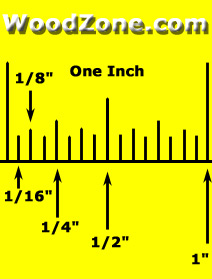"You could ask ‘if it says 2.5 centimeters on the ruler how many inches is that’? Another question could be, ‘if the ruler says it is 20 millimeters then how many centimeters is this’?
Rulers have long been made of wood in a wide range of sizes. They are not however all wood. Plastics have been used since they were invented; they can be mouldedmolded with length markings instead of being scribed. Metal is used for more durable rulers for use in the workshop; sometimes a metal edge is embedded into a wooden desk ruler to preserve the edge when used for straight-line cutting.
12 inches or 30 cm in length is useful for a ruler to be kept on a desk to help in drawing. Shorter rulers are convenient for keeping in a pocket. Longer rulers, e.g., 18 inches (45 cm) are necessary in some cases. Rigid wooden or plastic yardsticks, 1 yard long and meter sticks, 1 meter long, are also used. Classically, long measuring rods were used for larger projects, now superseded by tape measure or laser rangefinders.
Desk rulers are used for three main purposes: To measure, to aid in drawing straight lines and as a straight guide for cutting and scoring with a blade. Practical rulers have distance markings along their edges.
A type of ruler used in the printing industry is called a line gauge. These may be made from a variety of materials, typically metal or clear plastic. Units of measurement on a basic line gauge usually include inches, agate, picas, and points. More detailed line gauges may contain sample widths of lines, samples of common type in several point sizes, etc."
Rulers have long been made of wood in a wide range of sizes. They are not however all wood. Plastics have been used since they were invented; they can be mouldedmolded with length markings instead of being scribed. Metal is used for more durable rulers for use in the workshop; sometimes a metal edge is embedded into a wooden desk ruler to preserve the edge when used for straight-line cutting.
12 inches or 30 cm in length is useful for a ruler to be kept on a desk to help in drawing. Shorter rulers are convenient for keeping in a pocket. Longer rulers, e.g., 18 inches (45 cm) are necessary in some cases. Rigid wooden or plastic yardsticks, 1 yard long and meter sticks, 1 meter long, are also used. Classically, long measuring rods were used for larger projects, now superseded by tape measure or laser rangefinders.
Desk rulers are used for three main purposes: To measure, to aid in drawing straight lines and as a straight guide for cutting and scoring with a blade. Practical rulers have distance markings along their edges.
A type of ruler used in the printing industry is called a line gauge. These may be made from a variety of materials, typically metal or clear plastic. Units of measurement on a basic line gauge usually include inches, agate, picas, and points. More detailed line gauges may contain sample widths of lines, samples of common type in several point sizes, etc."
